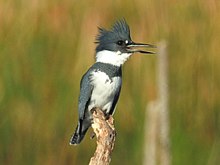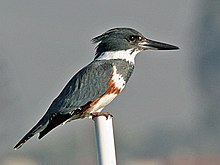| Belted kingfisher | |
|---|---|

| |
| Adult male | |

| |
| Adult female | |
| Conservation status | |
 Least Concern (IUCN 3.1) | |
| Scientific classification | |
| Domain: | Eukaryota |
| Kingdom: | Animalia |
| Phylum: | Chordata |
| Class: | Aves |
| Order: | Coraciiformes |
| Family: | Alcedinidae |
| Subfamily: | Cerylinae |
| Genus: | Megaceryle |
| Species: | M. alcyon |
| Binomial name | |
| Megaceryle alcyon (Linnaeus, 1758) | |

| |
| Approximate distribution map Breeding Year-round Nonbreeding | |
| Synonyms | |
| |
The belted kingfisher (Megaceryle alcyon) is a large, conspicuous water kingfisher, native to North America. All kingfishers are placed in one family, Alcedinidae, and recent research suggests that this should be divided into three subfamilies.
Taxonomy
The first formal description of the belted kingfisher was by the Swedish naturalist Carl Linnaeus in 1758 in the tenth edition of his Systema Naturae. He introduced the binomial name Alcedo alcyon. The current genus Megaceryle was erected by the German naturalist Johann Jakob Kaup in 1848. Megaceryle is from the Ancient Greek megas, "great", and the existing genus Ceryle. The specific alcyon is Latin for "kingfisher".
The Megaceryle large green kingfishers were formerly placed in Ceryle with the pied kingfisher, but the latter is closer to the Chloroceryle American green kingfishers. The belted kingfisher's closest living relative is the ringed kingfisher (M. torquata), and these two in all probability originated from an African Megaceryle which colonized the Americas.
Description
The belted kingfisher is a stocky, medium-sized bird that measures between 28–35 cm (11–14 in) in length with a wingspan of between 48–58 cm (19–23 in). This kingfisher can weigh from 113 to 178 g (4.0 to 6.3 oz). The adult female averages slightly larger than the adult male.
This species has a large head with a shaggy crest. Its long, heavy bill is black with a grey base. These features are common in many kingfisher species. This kingfisher shows reverse sexual dimorphism, with the female more brightly coloured than the male. Both sexes have a slate blue head, large white collar, a large blue band on the breast, and white underparts. The back and wings are slate blue with black feather tips with little white dots. The female features a rufous band across the upper belly that extends down the flanks. Juveniles of this species are similar to adults, but both sexes feature the rufous band on the upper belly. Juvenile males will have a rufous band that is somewhat mottled while the band on juvenile females will be much thinner than that of adult females.
Distribution and habitat
The only kingfisher in the majority of its range, the belted kingfisher's breeding habitat is near inland bodies of waters or coasts across most of North America, within Canada, Alaska and the United States. They migrate from the northern parts of its range to the southern United States, Mexico, Central America, and the West Indies in winter. It is a rare visitor to the northern areas of Colombia, Venezuela, and the Guianas. During migration it may stray far from land; the species is recorded as an accidental visitor on several Pacific islands, such as Cocos Island, Malpelo Island, Hawaii, the Azores, Clarion Island, and has occurred as an extremely rare vagrant in Ecuador, Greenland, Ireland, Netherlands, Portugal, and the United Kingdom. The southernmost records of M. alcyon are from the Galapagos Archipelago, insular Ecuador, where it occurs as a migrant in small numbers but apparently not every year.
It leaves northern parts of its range when the water freezes; in warmer areas, it is a permanent resident. A few individuals may linger in the north even in the coldest winters except in the Arctic, if there are remaining open bodies of water.
Ecology and behaviour

The belted kingfisher is often seen perched prominently on trees, posts, or other suitable watchpoints close to water before plunging in headfirst after its fish prey. They also eat amphibians, molluscs, small crustaceans, insects, small mammals, small birds, reptiles and berries.
As the kingfisher flies about its habitat, it frequently emits a characteristic rattling call. Accordingly, a small group of belted kingfishers is known as a rattle, concentration, or kerfuffle.
This bird nests in a horizontal tunnel made in a river bank or sand bank and excavated by both parents. The female lays five to eight eggs and both adults share the task of incubating the eggs and feeding the young. During the breeding season, males may also exhibit a strong degree of territoriality in the immediate vicinity of their nest, chasing away conspecifics and predators alike.
The nest of the belted kingfisher is a long tunnel and often slopes uphill. One possible reason for the uphill slope is that, in case of flooding, the chicks will be able to survive in the air pocket formed by the elevated end of the tunnel.
References
- ^ BirdLife International (2016). "Megaceryle alcyon". IUCN Red List of Threatened Species. 2016: e.T22683623A92992287. doi:10.2305/IUCN.UK.2016-3.RLTS.T22683623A92992287.en. Retrieved 12 November 2021.
- Linnaeus, C. (1758). Systema Naturæ per regna tria naturae, secundum classes, ordines, genera, species, cum characteribus, differentiis, synonymis, locis, Volume 1 (in Latin). Vol. v.1 (10th ed.). Holmiae:Laurentii Salvii. p. 115.
- Kaup, Johann Jakob (1848). "Die Familie der Eisvögel (Alcedidae)". Verhandlungen des Naturhistorischen Vereins für das Großherzogthum Hessen und Umgebung (in German). 2: 68. OCLC 183221382.
- Jobling, James A (2010). The Helm Dictionary of Scientific Bird Names. London: Christopher Helm. pp. 40, 245. ISBN 978-1-4081-2501-4.
- Moyle, Robert G. (2006). "A molecular phylogeny of kingfishers (Alcedinidae) with insights into early biogeographic history". Auk. 123 (2): 487–499. doi:10.1642/0004-8038(2006)123[487:AMPOKA]2.0.CO;2. hdl:1808/16596. S2CID 84824051.
- Cornell Laboratories of Ornithology. "All About Birds: Belted Kingfisher". Archived from the original on 14 June 2008. Retrieved 12 June 2008.
- "Belted kingfisher videos, photos and facts – Megaceryle alcyon". ARKive. 2013-03-27. Archived from the original on 2010-12-21. Retrieved 2013-03-31.
- Alderfer, Jonathan, ed. (2008). National Geographic Complete Birds of North America. Washington, D.C.: National Geographic. p. 362. ISBN 978-0-7922-4175-1.
- Ridway, R. (1914). "The birds of North and Middle America: A descriptive catalogue of the higher groups, genera, species, and subspecies of birds known to occur in North America, from the Arctic lands to the Isthmus of Panama, the West Indies and other islands of the Caribbean Sea, and the Galapagos Archipelago. Part VI". Bulletin of the United States National Museum. 50: 1–902.
- Meyer de Schauensee, R. (1949). "The birds of the Republic of Colombia [Accipitridae–Picidae]". Caldasia. 5 (23): 381–644.
- Renaudier, A.; Comite d'Homologation de Guyane (2010). "Rare birds in French Guiana in 2005–07" (PDF). Cotinga (32): 95–104.
- Henshaw, H.W. (April 1902). "Belted Kingfisher in the Island of Hawaii". Auk. 19 (2): 199. doi:10.2307/4069320. JSTOR 4069320.
- ^ Cisneros-Heredia, Diego F. (2016). "First documented record of the Belted Kingfisher Megaceryle alcyon (Linnaeus, 1758) in mainland Ecuador". PeerJ Preprints. 4 (e1896v1). PeerJ. doi:10.7287/peerj.preprints.1896v1.
- Brattstrom, Bayard H.; Howell, Thomas R. (1956). "The Birds of the Revilla Gigedo Islands, Mexico" (PDF). Condor. 58 (2). Cooper Ornithological Society: 107–120. doi:10.2307/1364977. JSTOR 1364977.
- Halliday, Josh (2022-01-05). "Rare kingfisher sighting in Preston draws thousands". The Guardian. Retrieved 2022-01-06.
- Lévêque, R.; Bowman, R.I.; Billeb, S.L. (1966). "Migrants in the Galápagos area". Condor. 68 (1). Cooper Ornithological Society: 81–101. doi:10.2307/1365177. JSTOR 1365177.
- Harris, M.P. (1973). "The Galápagos Avifauna". Condor. 75 (3). Cooper Ornithological Society: 265–278. doi:10.2307/1366166. JSTOR 1366166.
- Wiedenfeld, D.A. (2006). "Aves, The Galapagos Islands, Ecuador". Check List. 2 (2): 1–27. doi:10.15560/2.2.1.
- Henninger, W.F. (1906). "A preliminary list of the birds of Seneca County, Ohio" (PDF). Wilson Bulletin. 18 (2): 47–60.
- "Megaceryle alcyon (Belted kingfisher)". Animal Diversity Web.
- ^ Cornell Laboratories of Ornithology. "All About Birds: Belted Kingfisher". Archived from the original on March 21, 2009. Retrieved 19 June 2009.
- "Do You Know the Proper Names for Different Bird Flocks?". The Spruce. Retrieved 2022-02-26.
- Parnell, Marc (2022). Birds of Alabama (The Birding Pro's Field Guides). Cleveland, Ohio: Naturalist & Traveler Press. pp. 114–115. ISBN 9781954228252.
Further reading
- Cramp, Stanley, ed. (1985). "Ceryle alcyon Belted Kingfisher". Handbook of the birds of Europe the Middle East and North Africa. The Birds of the Western Palearctic. Volume IV: Terns to Woodpeckers. Oxford: Oxford University Press. pp. 731–733. ISBN 0-19-857507-6.
- Fry, C. Hilary; Fry, Kathie; Harris, Alan (1992). Kingfishers, Bee-eaters, and Rollers. London: Christopher Helm. pp. 234–236. ISBN 978-0-7136-8028-7.
External links
- Belted Kingfisher – Ceryle alcyon – USGS Patuxent Bird Identification InfoCenter
- "Belted Kingfisher media". Internet Bird Collection.
- Belted Kingfisher photo gallery at VIREO (Drexel University)
- Oiseaux.net Photos
- Belted Kingfisher Bird Sound at Florida Museum of Natural History
| Water kingfishers | |
|---|---|
| |
| Megaceryle |
|
| Ceryle |
|
| Chloroceryle |
|
| 9 living species in 3 genera | |
| Taxon identifiers | |
|---|---|
| Megaceryle alcyon |
|
| Alcedo alcyon | |